Keywords: Bacon; natural history; experiment; observation; natural magic; merchants;
Th is essay explores the natural history project that Bacon undertakes in the last part of his life. After setting aside the Novum organum and the attempt to set out a method of interpreting nature in detail, Bacon turned to the project of outlining what a natural history should look like. Part of this project involved the composition of some natural histories to serve as models of what a natural history should look like. He published two of six exemplary histories he planned, the Historia vitae et mortis and the Historia ventorum. Both of these are very carefully organized works in learned Latin. However, shortly after his death, William Rawley, his literary executor, published Bacon’s Sylva Sylvarum, presented as “a natural history in ten centuries.” Th e style of this work is altogether diff erent from the Latin natural histories: it is in English, not Latin, and, as Rawley put it in his letter to the reader, “it may seeme an Indigested Heap of Particulars.” In this essay, I discuss the relations between the formal Latin natural histories and the Sylva. Appealing to the structure of Salomon’s House in the New Atlantis, published in the same volume as the Sylva, I argue that the Sylva Sylvarum represents the very fi rst stages of constructing a natural history, while the Latin natural histories represent later stages in the process, where the observations, experiments, and other materials collected from various sources are arrayed in a more orderly and systematic fashion.
More...Mogens Lærke, Justin E. H. Smith, Eric Schliesser (eds.), Philosophy and its History: Aims and Methods in the Study of Early Modern Philosophy, Oxford: Oxford University Press, 2013, 384 pp. Lawrence Nolan (ed.), Primary and Secondary Qualities. The Historical and Ongoing Debate, Oxford: Oxford University Press, 2011, x + 404 pp.
More...Notes by Tereza CULIANU-PETRESCU and Dan PETRESCU, Iasi-Bucharest Foreword by Matei CÃLINESCU, University of Indiana, Bloomington. Translated from Romanian by Sorana CORNEANU
More...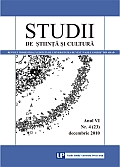
Keywords: Bacon; education; knowledge; New Atlantis; parable; educaţie; cunoaştere; Noua Atlantidă; parabolă.
In De augmentis scientiarum (1623), Francis Bacon developed his discussion of “poesy” first broached in the earlier English version of the tract, The Advancement of Learning (1605), and explained in more detail the partition of that realm of learning into narrative, dramatic and parabolical types of poesy. In this paper I discuss Bacon’s The New Atlantis (1627) from the point of view of this partition, and draw attention to the topic of persuasion, which is pertinent to all the types of poesy, but also, in a wider sense, to Bacon’s views about the transmission of natural philosophical knowledge and the epistemology of natural philosophical method. Across these domains, the question of persuasion, or else the question of the formation, manipulation and transmission of beliefs, governs a cluster of themes which include those of authority, credulity, education and reformation. In all these domains, Bacon advocated a dynamic, fruit-bearing approach to knowledge, in contrast with a growth-blocking embracing of authority, represented, respectively, by the eloquent images of the vine and the statue. I would like to suggest that, by looking at The New Atlantis from the perspective of Bacon’s more general reflections on these themes, this text may be seen as a parable about the nature of persuasion itself. This will also be to argue for the cross-fertilization in the late Renaissance between the fields of literature and science.
More...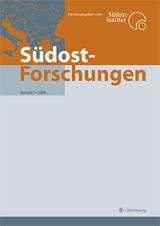
Michael Schmidt-Neke: Th omas KACZA, Zwischen Feudalismus und Stalinismus. Albanische Geschichte des 19. und 20. Jahrhunderts. Berlin: Trafo-Verlag 2007. 389 S., ISBN 978-3-89626-611-8, Klaus Buchenau : Bojan ALEKSOV, Religious Dissent between the Modern and the National. Nazarenes in Hungary and Serbia 1850-1914. Wiesbaden: Harrassowitz 2006 (Balkanologische Veröff entlichungen, 43). 205 S., ISBN 3-447-05397-6 Ekkeha rd Kr a f t: Spyridōn G. PLUMIDĒS, Εθνοτική συμβίωση στα Βαλκάνια. ΄Ελληνες και Βούλγαροι στη Φιλιππούπολη, 1878-1914 [Ethnisches Zusammenleben auf dem Balkan. Griechen und Bulgaren in Plovdiv, 1878-1914]. Athen: Εκδόσεις Πατάκη 2006 (Νεότερη και σύγχρονη ιστορία, 19). 470 S., ISBN 960-16-1988-7 Reinhard Reimann: Sane RUTAR, Kultur – Nation – Milieu. Sozialdemokratie in Triest vor dem Ersten Weltkrieg. Essen: Klartext 2004 (Veröff entlichungen des Instituts für soziale Bewegungen, Schriftenreihe A, 23). 384 S., ISBN 3-89861-116-7 Franz Sz. Horváth: ic Beckett WEAVER, National narcissism. Th e intersection of the nationalist cult and gender in Hungary. Oxford, Bern, Berlin u. a.: Peter Lang 2006. 246 S., ISBN 3-03910-726-7 Stefan Di e t r i c h: ort zwischen Ost und West. Beiträge zur Sportgeschichte Osteuropas im 19. und 0. Jahrhundert. Hgg. Arié Malz / Stefan Rohdewald / Stefan Wiederkehr. Osnabrück: fi bre Verlag 2007. 377S., ISBN 978-3-938400-15-9 Wolfgang Ke s s l e r: fi nitionsmacht, Utopie, Vergeltungen. „Ethnische Säuberungen“ im östlichen Europa des 20. Jahrhunderts. Hgg. Ulf Brunnbauer / Michael G. Esch / Holm Sundhaussen. Berlin: Lit Verlag 2006 (Geschichte. Forschung und Wissenschaft, 9). 304 S., ISBN 978-3-8258-8033-0 Eva Anne Frantz: keria CANA, Politika e Serbisë kundrejt çështjes shqiptare, 1903-1913 [Die Politik erbiens gegenüber der albanischen Frage 1903-1913]. Prishtinë: Instituti Albanologjik i Prishtinës, Shtypshkronja „KGT“ 2006. 557 S., ISBN 9951-411-31-2
More...Keywords: hesyhasm; Ioan Casian; Diadoh al Foticeii; Varsanufie si Ioan din Gaza; Simeon Noul Teolog; Grigorie Sinaitul; Maxim Kavsokalivitul; Grigorie Palama; Nicodim Aghioritul; Teodora de la Sihla; Neagoe Basarab
La définition que nous avons choisie pour „le hesychasme” est la suivante: faire l’expérience de la vérité théologique, à savoir, Dieu peut être connu par Sa grâce, cela étant le fruit de la pratique de la prière sans cesse et de la contemplation de la lumière de Thabor. Après avoir expliqué les multiples sens du terme „le hesychasme”, nous avons fait une courte histoire de la tradition hesychaste byzantine et nous l’avons séparée en deux : la phase sinaïte (Diadoque de Photicé (458), Barsanuphe et Jean de Gaza (+540), Saint Jean du Climaque (+649), Saint Syméon le Nouveau Théologien (+1022), Saint Grégoire le Sinaïte (+1346) et la phase athonite: (Saint Maxime Kavsokaliveé, Saint Grégoire Palamas, Saint Nicodème Agiorite). Ensuite, nous avons eu en vue le problème de la tradition hesychaste chez les Roumains. Dans notre démarche nous avons constaté le fait que nous pouvons nous heurter à deux obstacles concernant la tradition hesychaste chez les Roumains avant XVIIe siècle: 1. la grave confusion entre l’histoire de l’hesychasme et l’histoire du monachisme roumain; 2. les sources historiques pour la détection de la présence hesychaste chez les Roumains avant XVIIIe siècle sont très pauvres. Le manque de ces sources historiques nous a déterminé de parler de la période de „l’implicite vécu” de la tradition hesychasme roumaine (le syntagme „l’implicite vécu” de l’hesychasme roumain suggère le fait qu’il y a eu des hesychastes qui menaient ce type de vie cachée aux yeux du monde. L’amour pour une vie hesychaste et de prière, pour solitude et contemplation de la lumière divine ne faisait pas l’objet d’un problème publique à la portée de tout le monde. La présence de l’hesychasme dans cette période est liée seulement à quelques déductions, corrélations des données et des documents légitimes qui attestent la possibilité d’existence de cette manière de vivre dans les Pays Roumains). Dans ce sens nous avons mis en discussion le problème des hesychastes de la pèriode d’avant XVIIIe siècle: „les ermitages villageoises”, l’ermitage hesychaste de Paroria (1325), les relations des Roumains avec „la laure roumaine” de Kutloumus, la présence des Roumains à Kelifarevo, établissement monacal créé par l’hesychaste Théodose, Saint Nicomède de Tismana – la correspondance avec l’hesychaste Euthimios, le patriarche de Tarnovo (1375-1393), Sainte Théodora de Sihla (=„forêt jeune et très touffue”), l’isihasteé qui avait la prière ardente sur ses lèvres – XVIIe siècle, et „Les Enseignements de Neagoe Basarab” – une synthèse entre hesychasme et politique.
More...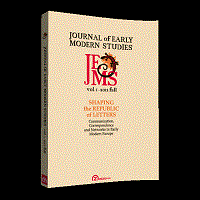

Evan R. Ragland, Between Certain Metaphysics and the Senses: Cataloging and Evaluating Cartesian Empiricisms [Mihnea Dobre and Tammy Nyden (eds.), Cartesian Empiricisms, Studies in the History and Philosophy of Science 33, Dordrecht: Springer, 2013] Descartes insisted on his metaphysics of a human being as a single, immaterial thinking mind united to a body, but sometimes he seems of two minds about the uses of experience in natural philosophy. In his 1637 Discourse on Method, Descartes writes of first considering God alone, then deriving general principles “from certain seeds of truth which are naturally in our souls.” Next, the “first and most ordinary effects” deducible from those principles allowed him to discover the heavens, the earth, water, fire, minerals—the simplest and most common things, and so the easiest to know. But then things become more complicated and more variable.
More...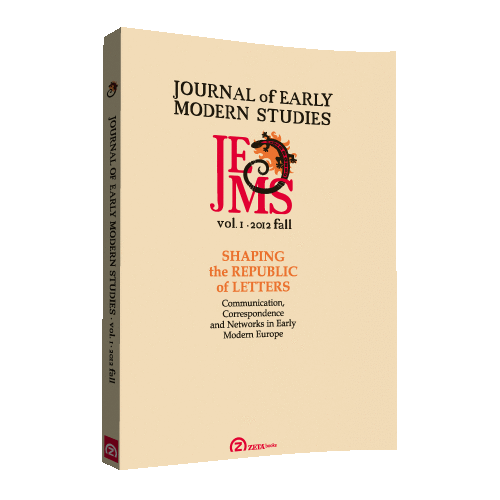
Keywords: glass drop; experiment; Robert Hooke; Henricus Regius; Nicholas Poisson; Jacques Rohault
The glass drop is a tear-shaped object with many curious properties. Although having a fragile tail, its main body is hard to break. On the other hand, breaking such a drop produces a loud noise and many very small particles of glass. In the seventeenth century, these objects became the focus of both experimental and natural philosophical investigation. In this article, I examine the ways in which various natural philosophers have dealt with glass-drops. This is neither a complete enumeration of the countless attempts to explain the object and its associated phenomena, nor a search for its origins. Rather, this study offers a glimpse into what was at stake in the inclusion of the glass drop—a new scientific object—into natural philosophy. I shall argue that a full description of the drop and of its properties required both experiment and speculation.
More...


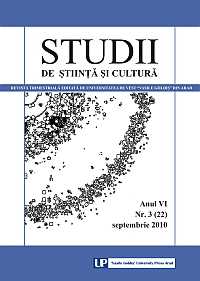
Keywords: Ioan Flora; identity; intertextuality; postmodernism; syntax; Ioan Flora; identitate; intertextualitate; postmodernism; sintaxă
Existential and stylistic liminality explains, with respect to the Romanian poet from the Serbian Banat, the atypical nature of his poetics. As a minority representative in Serbia and an outsider in Romania, Flora has “enjoyed” rather some global and complaisant labelling than really pertinent analyses. Although he belongs, biologically, to the ‘80s generation, his welltempered postmodernism, cohabitating with neomodernism, deserves special attention. This is precisely the aim of this article, which will be centred on three defining coordinates: (a) the text “document” and the poetics of the real; (b) intertextuality: relational identity and mythical symbols; (c) the rhetoric of discourse: tropes, syntax, metadiscourse.
More...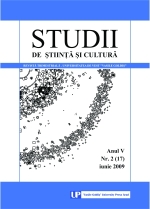
Keywords: : enunciation; inspiration; metatext; trans-coding; enunţare; inspiraţie; metatext; transcodare
The present article aims at (a) presenting the polymorphism of Arghezi's explicit metatexts; (b) correcting thus the prejudice of Testament's centrality in his modern poetics; (c) explaining the pragma-semantic aspects assumed by performative enunciation and presupposed by illocutionary and perlocutionary acts of reader-response processes. The four types of the text's production are: the hypercodification (Testament), the inspiration (Incertitudine), the minor trans-coding (Cuvânt), the free structures ("versuri descălţate"). From the "poetic arts" one can extrapolate not only Arghezi's poetics but also a general baroque poetics.
More...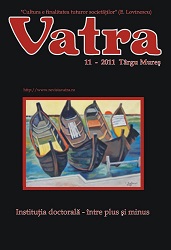
Se pare că la intervale regulate cultura română are nevoie să se întoarcă nu numai la Maiorescu sau Caragiale pentru a se regăsi, ci şi la întemeietorul spiritului critic, Mihail Kogălniceanu. Avem nevoie de un nou Kogălniceanu, nu pentru a combate „traducţiile”, ci alte producţii culturale la fel de păguboase, care au devenit la noi o manie periculoasă: doctoratele. Poate că ele nu omoară în noi duhul naţional, dar cu siguranţă sunt un atentat la adresa adevăratelor valori, cultivând degringolada într-un domeniu considerat a fi rezervat elitelor. De ceva timp încoace, instituţia doctorală românească pare să-şi fi uitat atât de mult menirea iniţială, încât a ajuns exact opusul a ceea ce fusese cândva: dintr-o formă de selecţie a valorilor, a ajuns o altă formă de confuzie a valorilor. Sigur, putem găsi nu unul, ci o serie de ţapi ispăşitori: o fi vina relativismului postmodern sau a celui românesc, a şirului de reforme dezastruoase care s-au ţinut lanţ în ultimii douăzeci de ani, a guvernării liberale sau a crizei economice.
More...